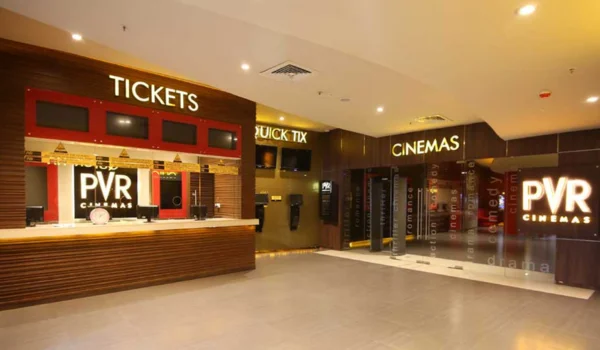PVR INOX (formed by PVR Cinemas and INOX Leisure merger in 2023) is the largest multiplex chain in India, with 1,749 screens across 355 properties in 111+ cities including Sri Lanka. It offers premium formats (Gold Class, IMAX, 4DX, etc.) and has recently emphasized a Franchise Owned, Company Operated (FOCO) model to expand into Tier II–III markets.
Franchise Model & Space Requirements
- FOCO Model: Local investors provide the property, while PVR manages design, staffing, technology, and operations .
- Required Space: Typically 5,000–10,000 sq ft, depending on number of screens.
This model enables investors to leverage PVR’s expertise and technology without operational burden.
Investment Breakdown
| Component | Estimated Range |
|---|---|
| Franchise Fee | ₹1–1.0 Cr |
| Fits‑out, Projection, Seatings | ₹2–5 Cr (varies with male/female seating, tech, screen type) |
| Working Capital & Soft Costs | ₹1 Cr (staff, utilities, marketing) |
| Total Investment | ₹5–8 Cr (can escalate to ₹10 Cr in top metros) |
- Franchise fee is often ₹10 L–₹1 Cr; industry sources quote around ₹1 Cr .
- Capex per screen: In premium formats, ₹3 Cr per screen (50–100% more than standard).
- Overall investment range is ₹5–10 Cr depending on format and location.
Revenue Model, Royalty & Profit Margins

- Revenue Streams: Ticket sales (~54%), F&B (~32%), advertising, convenience fees.
- Royalty & Marketing Fees: Typically 8–10% of gross revenues.
- Net Profit Margins: Franchisees can expect net margins of 6–8%, with added revenues through F&B and partner kiosks.
ROI & Payback Period
Based on ₹5 Cr investment with conservative performance:
- Annual revenue: ₹10–15 Cr (depending on location & screens)
- Net margin (6–8%): ₹60–120 L profit/year
- ROI Payback: ~3–5 years for standard screens; premium formats may extend to 5+ years due to high capex
Industry projections estimate break-even in 2–3 years, with full ROI within 4–5 years .
Eligibility Criteria
Interested investors need:
- Capital: ₹5–10 Cr liquid funds to fund capex, working capital, and contingency.
- Property Access: 5,000–10,000 sq ft suitable space, either mall-based or standalone.
- Business Backing: Strong financial history; PVR will conduct due diligence.
- Compliance: Licenses like fire NOC, occupancy, GST, trademark, environmental clearance.
- Partnership Model: Best suited for investors who prefer own-property model with professional operations handled by PVR.
Advantages & Support
Franchisees backing under FOCO model enjoy:
- Operational Expertise: PVR runs staffing, ticketing, customer service, tech systems.
- Brand & Content: Guaranteed access to quality film content and established brand positioning.
- Marketing & Promotions: National campaigns, loyalty programs, and local tie-ups.
- Premium Formats: Access to differentiated formats (IMAX, 4DX, Gold Class) to drive ticket pricing and occupancy.
- Cost Sharing: Shared capex risk, reduced operating burden.
The trade-off is lower margin share compared to self-run standalone cinema, but compensated by PVR’s scale and expertise.
Application & Setup Steps
Initial Enquiry
Submit interest via PVR franchise/INOX partnership portal.
Property Submission
Provide details of location, area, demographics.
Due Diligence
PVR evaluates location feasibility, population catchment, financial viability.
Commercial Terms Negotiation
Agree on franchise fee, revenue sharing terms, screen configuration.
Franchise Agreement
Typically structured for 5–15 years, depending on contract negotiation.
Design & Fit-Out
PVR architects design theatre layout. Investor shoulders capex under PVR guidelines.
Staff & Systems
PVR handles recruitment, staff training, POS, and cinema management software.
Pilot Operations
Soft launch to test systems and workflow.
Grand Launch
Opening event with full operational support and marketing activation.
Ongoing Operations
PVR continues operations, scheduling, marketing; investor receives periodic returns.
Challenges & Considerations
- Significant Capital Outlay: ₹5–10 Cr plus working capital is a substantial investment.
- Dependency on PVR: Investors cede daily operational control under FOCO model.
- Market Risk: Box office performance is content-dependent and sensitive to epidemic waves or OTT shifts.
- Long Payback: Break-even longer than smaller retail franchises, with 3–5 years to payback.
- Space & Location: Success depends heavily on right-sized, high-traffic venue.
Is a PVR Franchise Worth It?
✅ For property-owning investors: A FOCO PVR franchise lets you monetize real estate while leveraging a top entertainment brand.
✅ Professional operations: PVR minimizes learning curve via turnkey execution.
✅ Premium formats: Additional high-margin earning on experiential screens.
✅ Diversified income: Ticket sales, F&B, ad revenues, with stabilised occupancy via loyalty.
However, ensure you’re comfortable with the capital scale, revenue share, and long-term commitment involved.
🔧 Next Steps for Aspiring Franchisees
- Review your capital—liquidity and financing ability.
- Select potential properties meeting size & traffic criteria.
- Contact PVR/INOX franchise team with a detailed property proposal.
- Conduct feasibility study, including projected footfall and competition.
- Negotiate phases: screens, brand tie-up, revenue share, contract term.
- Engage financial/legal advisors for term sheet and agreement review.
- Prepare for launch: finalize design, capex, staff hiring and fit-out.
- Collaborate during pilot, refine based on initial learnings.
- Scale operations and explore multi-screen opportunities under ongoing PVR expansion.
Final Thoughts
A PVR INOX FOCO franchise is a high-investment, high-potential model—ideal for investors with suitable real estate who want exposure to the entertainment industry without direct operational complexities. With PVR’s brand, technology, and content edge, your investment can generate sustainable returns, diversify your asset base, and tap into India’s growing appetite for cinematic experiences—especially in premium and emerging markets.

Shashi Kant is the Founder and Editor of BusinessScroller.com, a leading platform for business insights, finance trends, and industry analysis. With a passion for journalism and expertise in business reporting, he curates well-researched content on market strategies, startups, and corporate success stories. His vision is to provide valuable information that empowers entrepreneurs and professionals. Under his leadership, BusinessScroller.com has grown into a trusted source for in-depth articles, customer care guides, and financial expertise.



I went this business